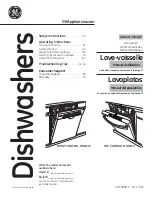
3
atmosphere and public health. The
crossed-out dustbin symbol shown on
all products reminds the owners of their
obligations regarding separated waste
collection.
For further information relating to
the correct disposal of household
appliances, owners may contact the
relevant public authority or the local
appliance dealer.
Saving energy and respecting the
environment
Saving water and energy
• Only begin a wash cycle when the
dishwasher is full. While waiting for
the dishwasher to be filled, prevent
unpleasant odours with the Soak cycle
(if available, see Wash Cycles).
• Select a wash cycle that is suited to the
type of crockery and to the soil level
using the Table of Wash Cycles:
- For dishes with a normal soil level, use
the Eco wash cycle, which guarantees
low energy and water consumption
levels.
- If the load is smaller than usual activate
the Half Load option
(see Special wash cycles
and options, if available).
• If your electricity supply contract gives
details of electricity-saving time bands,
run the wash cycles when electricity
prices are lower. The DELAYED START
option can help you organise the wash
cycles accordingly
(
see Special wash cycles
and options, if available).
Product Fiche
Brand
INDESIT
Model
DIFP 8T96
Rated capacity in standard place settings (1)
14
Energy efficiency class on a scale from A+++ (low consumption) to D (high consumption)
A++
Energy consumption per year in kWh (2)
265.0
Energy consumption of the standard cleaning cycle in kWh
0.93
Power consumption of the off-mode in W
0.5
Power consumption of the left-on mode in W
5.0
Water consumption per year in litres (3)
2520.0
Drying efficacy class on a scale from G (low efficacy) to A (high efficacy)
A
Programme time for standard cleaning cycle in minutes
190
The duration of the left-on mode in minutes
12
Noise in dB(A) Re 1pW
46
Built-in model
Yes
NOTES
1) The information on the label and fiche relates to the standard cleaning cycle, this programme is suitable to clean normally soiled
tableware and it is the most efficient programme in terms of combined energy and water consumption. The standard cleaning cycle
corresponds to the Eco cycle.
2) Based on 280 standard cleaning cycles using cold water fill and the consumption of the low power modes. Actual energy consumption
depends on how the appliance is used.
3) Based on 280 standard cleaning cycles. Actual water consumption depends on how the appliance is used.
Product Data (product fiche)
EN
Assistance
Before contacting Assistance:
• Check whether the problem can be resolved using the
Troubleshooting guide
(see Troubleshooting).
• Restart the programme to check whether the problem
has ceased to exist.
• If the problem persists, contact the Authorised Technical
Assistance Service.
Never use the services of unauthorised technicians.
Please have the following information to hand:
• The type of malfunction.
• The appliance model (Mod.).
• The serial number (S/N).
This information can be found on the appliance data plate
(see Description of the appliance).




































